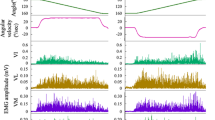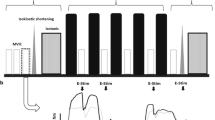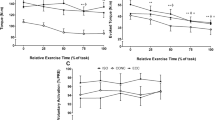Summary
The aim of this investigation was to study the relationships among movement velocity, torque output and electromyographic (EMG) activity of the knee extensor muscles under eccentric and concentric loading. Fourteen male subjects performed maximal voluntary eccentric and concentric constant-velocity knee extensions at 45, 90, 180 and 360° · s−1. Myoelectric signals were recorded, using surface electrodes, from the vastus medialis, vastus lateralis and rectus femoris muscles. For comparison, torque and full-wave rectified EMG signals were amplitude-averaged through the central half (30°–70°) of the range of motion. For each test velocity, eccentric torque was greater than concentric torque (range of mean differences: 20%–146%,P < 0.05). In contrast, EMG activity for all muscles was lower under eccentric loading than velocity-matched concentric loading (7%–31%,P < 0.05). Neither torque output nor EMG activity for the three muscles changed across eccentric test velocities (P > 0.05). While concentric torque increased with decreasing velocity, EMG activity for all muscles decreased with decreasing velocity (P < 0.05). These data suggest that under certain high-tension loading conditions (especially during eccentric muscle actions), the neural drive to the agonist muscles was reduced, despite maximal voluntary effort. This may protect the musculoskeletal system from an injury that could result if the muscle was to become fully activated under these conditions.
Similar content being viewed by others
References
Caiozzo VJ, Perrine JJ, Edgerton VR (1981) Training-induced alterations of the in vivo force-velocity relationship of human muscle. J Appl Physiol 51:750–754
Carew TJ (1981) Spinal cord I & II. In: Kandel ER, Schwartz JH (eds) Principles of neural science. Arnold, London, pp 284–304
Colliander EB, Tesch PA (1989) Bilateral eccentric and concentric torque of the quadriceps and hamstring muscles in females and males. Eur J Appl Physiol 59:227–232
Edman KAP, Elzinga G, Noble MIM (1978) Enhancement of mechanical performance by stretch during tetanic contractions of vertebrate skeletal muscle fibres. J Physiol 281:139–155
Eloranta V, Komi PV (1980) Function of the quadriceps femoris muscle under maximal concentric and eccentric contractions. Electromyogr Clin Neurophysiol 20:159–174
Gravel D, Belanger AY, Richards CL (1988) Study of human muscle contraction using electrically evoked twitch responses during passive shortening and lengthening. Eur J Appl Physiol 56:623–627
Hageman P, Gillespie D, Hill L (1988) Effect of speed and limb dominance on eccentric and concentric isokinetic testing of the knee. J Orthop Sports Phys Ther 10:59–65
Hortobágyi T, Katch FI (1990) Eccentric and concentric torque-velocity relationships during arm flexion and extension. Eur J Appl Physiol 60:395–401
Houk J, Henneman E (1967) Responses of Golgi tendon organs to active contractions of the soleus muscle in cat. J Neurophysiol 30:466–481
Laporte Y, Lloyd D (1952) Nature and significance of the reflex connections established by large afferent fibers of neural origin. Am J Physiol 169:609–621
Levin A, Wyman J (1927) The viscous elastic properties of muscle. Proc R Soc Lond [Biol] 101:218–243
Matthews BHC (1933) Nerve endings in mammalian muscle. J Physiol 78:1–53
Perrine JJ, Edgerton VR (1978) Muscle force-velocity and power-velocity relationships under isokinetic loading. Med Sci Sports Exerc 10:159–166
Phillips CA, Petrofsky JS (1980) Velocity of contraction of skeletal muscle as a function of activation and fiber composition: a mathematical model. J Biochem 13:549–558
Sale DG (1988) Neural adaptation to resistance training. Med Sci Sports Exerc 20:S135-S145
Seger JY, Westing SH, Hanson M, Karlson E, Ekblom B (1988) A new dynamometer measuring concentric and eccentric muscle strength during accelerated, decelerated, or isokinetic movements. Eur J Appl Physiol 57:526–530
Seliger V, Dolejs L, Karas V (1980) A dynamometric comparison of maximum eccentric, concentric and isometric contractions using EMG and energy expenditure measurements. Eur J Appl Physiol 45:235–244
Stauber WT (1989) Eccentric action of muscles: physiology, injury, and adaptation. Exerc Sport Sci Rev 17:157–185
Tesch PA, Dudley GA, Duvoisin MR, Hather BM (1990) Force and EMG signal patterns during repeated bouts of concentric and eccentric muscle actions. Acta Physiol Scand 138:263–271
Tredinnick T, Duncan P (1988) Reliability of measurements of concentric and eccentric isokinetic loading. Phys Ther 68:656–659
Triolo R, Robinson D, Gardner E, Betz R (1978) The eccentric strength of electrically stimulated paralyzed muscle. IEEE Trans Biomed Eng 9:651–652
Westing SH, Seger JY, Karlson E, Ekblom B (1988) Eccentric and concentric torque-velocity characteristics of the quadriceps femoris in man. Eur J Appl Physiol 58:100–104
Westing SH, Seger JY, Thorstensson A (1990) Effects of electrical stimulation on eccentric and concentric torque-velocity relationships during knee extension in man. Acta Physiol Scand 140:17–22
Wickiewicz TL, Roy RR, Powell PL, Perrine JJ, Edgerton VR (1984) Muscle architecture and force-velocity relationships in humans. J Appl Physiol 57:435–443
Author information
Authors and Affiliations
Rights and permissions
About this article
Cite this article
Westing, S.H., Cresswell, A.G. & Thorstensson, A. Muscle activation during maximal voluntary eccentric and concentric knee extension. Europ. J. Appl. Physiol. 62, 104–108 (1991). https://doi.org/10.1007/BF00626764
Accepted:
Issue Date:
DOI: https://doi.org/10.1007/BF00626764




